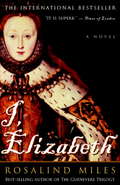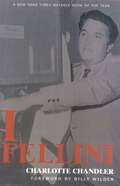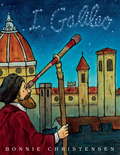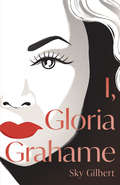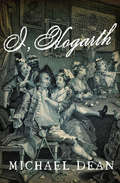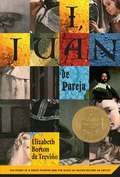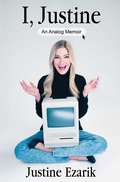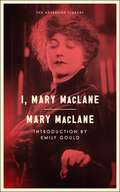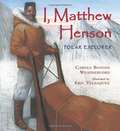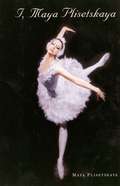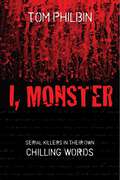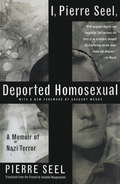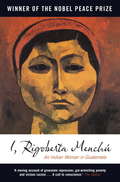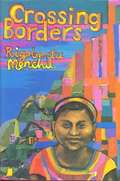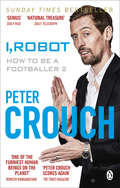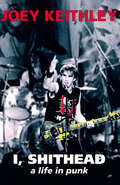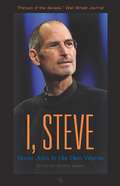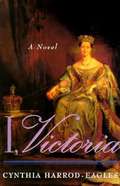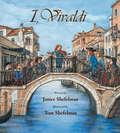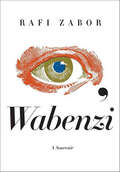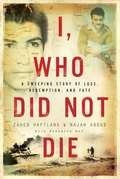- Table View
- List View
I, Elizabeth
by Rosalind MilesPublicly declared a bastard at the age of three, daughter of a disgraced and executed mother, last in the line of succession to the throne of England, Elizabeth I inherited an England ravaged by bloody religious conflict, at war with Spain and France, and badly in debt. When she died in 1603, after a forty-five- year reign, her empire spanned two continents and was united under one church, victorious in war, and blessed with an overflowing treasury. What's more, her favorites--William Shakespeare, Sir Francis Drake, and Sir Walter Raleigh--had made the Elizabethan era a cultural Golden Age still remembered today. But for Elizabeth the woman, tragedy went hand in hand with triumph. Politics and scandal forced the passionate queen to reject her true love, Robert Dudley, and to execute his stepson, her much-adored Lord Essex. Now in this spellbinding novel, Rosalind Miles brings to life the woman behind the myth. By turns imperious, brilliant, calculating, vain, and witty, this is the Elizabeth the world never knew. From the days of her brutal father, Henry VIII, to her final dying moments, Elizabeth tells her story in her own words. (From the Trade Paperback edition.)
I, Elizabeth: A Novel
by Rosalind MilesPublicly declared a bastard at the age of three, daughter of a disgraced and executed mother, last in the line of succession to the throne of England, Elizabeth I inherited an England ravaged by bloody religious conflict, at war with Spain and France, and badly in debt. When she died in 1603, after a forty-five- year reign, her empire spanned two continents and was united under one church, victorious in war, and blessed with an overflowing treasury. What's more, her favorites--William Shakespeare, Sir Francis Drake, and Sir Walter Raleigh--had made the Elizabethan era a cultural Golden Age still remembered today.But for Elizabeth the woman, tragedy went hand in hand with triumph. Politics and scandal forced the passionate queen to reject her true love, Robert Dudley, and to execute his stepson, her much-adored Lord Essex. Now in this spellbinding novel, Rosalind Miles brings to life the woman behind the myth. By turns imperious, brilliant, calculating, vain, and witty, this is the Elizabeth the world never knew. From the days of her brutal father, Henry VIII, to her final dying moments, Elizabeth tells her story in her own words.From the Trade Paperback edition.
I, Fellini
by Federico Fellini Charolette ChandlerForged from the many conversations Charlotte Chandler conducted with director Federico Fellini over the course of fourteen years, and featuring a forward by Billy Wilder, I, Fellini is a portrait of one of Italy's greatest filmmakers in his own words. In the book, Fellini recounts the stories behind his classic films La Dolce Vita, 8 1/2, La Strada, and others, describing the inspirations from which they arose and the struggles to get them filmed. He also speaks at length on actors Marcello Mastroianni, Anita Ekberg, Sophia Loren, and Anna Magnani, and on directors Roberto Rossellini, Ingmar Bergman, and Michelangelo Antonioni.
I, Galileo
by Bonnie ChristensenAcclaimed author-illustrator Bonnie Christensen adopts the voice of Galileo and lets him tell his own tale in this outstanding picture book biography. The first person narration gives this book a friendly, personal feel that makes Galileo's remarkable achievements and ideas completely accessible to young readers. And Christensen's artwork glows with the light of the stars he studied.Galileo's contributions were so numerous--the telescope! the microscope!--and his ideas so world-changing--the sun-centric solar system!--that Albert Einstein called him "the father of modern science." But in his own time he was branded a heretic and imprisoned in his home. He was a man who insisted on his right to pursue the truth, no matter what the cost--making his life as interesting and instructive as his ideas.
I, Gloria Grahame
by Sky GilbertA professor of English literature writes the autobiography of his fantasy alter-ego, wanton movie star Gloria Grahame, while his own sexual desires go frustrated.Denton Moulton — a shy, effeminate male professor — lives inside his head, where he is really a long-dead movie star: the glamorous Gloria Grahame, from the golden age of Hollywood. Professor Moulton is desperate to reveal Gloria’s shocking secret before he dies. Does he have the right to tell this woman’s story? Who, in fact, has the right to tell anyone’s story at all?A scandalous, humorous novel of taboo desires and repression, I, Gloria Grahame alternates between Gloria’s imagined life with her film-director husband, Nicholas Ray, director of Rebel Without a Cause, and Denton’s increasingly frustrated real-life attempts to produce his own work of art: an all-male drag production of Shakespeare’s Venus and Adonis. The novel takes us from high-strung film sets to dark bars and the puritanical offices of government arts granting agencies, where Denton runs up against the sternest warnings that he may not, in fact, imagine himself as someone else, even in art.A RARE MACHINES BOOK
I, Hogarth: A Novel
by Michael DeanThe great eighteenth century portraitist comes to life in this &“gritty, bawdy and funny&” rags to riches novel told in the voice of the artist himself (The New York Times). William Hogarth was London&’s artist par excellence, and his work—especially his satirical series of &“modern moral subjects&”—supplies the most enduring vision of the ebullience, enjoyments, and social iniquities of the eighteenth century. And in I, Hogarth, he tells a ripping good yarn. From a childhood spent in a debtor&’s prison to his death in the arms of his wife, Hogarth recounts the incredible story of how he maneuvered his way into the household of prominent artist Sir James Thornhill, and from there to become one of England&’s best portrait painters. Through his marriage to Jane Thornhill, his fight for the Copyright Act, his unfortunate dip into politics, and his untimely death, &“the voice in which Dean&’s Hogarth tells his own story is rich and persuasive . . . Like stepping into a Hogarth painting&” (The New York Times). &“A brilliant exercise in imagination and storytelling.&” —Kirkus Reviews (starred review)
I, Juan de Pareja
by Elizabeth Borton de TrevinoWhen the great Velázquez was painting his masterpieces at the Spanish court in the seventeenth century, his colors were expertly mixed and his canvases carefully prepared by his slave, Juan de Pareja. In a vibrant novel which depicts both the beauty and the cruelty of the time and place, Elizabeth Borton de Treviño tells the story of Juan, who was born a slave and died an accomplished and respected artist.<P><P> Upon the death of his indulgent mistress in Seville, Juan de Pareja was uprooted from the only home he had known and placed in the charge of a vicious gypsy muleteer to be sent north to his mistress’s nephew and heir, Diego Velázquez, who recognized at once the intelligence and gentle breeding which were to make Juan his indispensable assistant and companion—and his lifelong friend.<P> Through Juan’s eyes the reader sees Velázquez’s delightful family, his working habits and the character of the man, his relations with the shy yet devoted King Philip IV and with his fellow painters, Rubens and Murillo, the climate and customs of Spanish court life. When Velázquez discovers that he and Juan share a love for the art which is his very life, the painter proves his friendship in the most incredible fashion, for in those days it was forbidden by law for slaves to learn or practice the arts. Through the hardships of voyages to Italy, through the illnesses of Velázquez, Juan de Pareja loyally serves until the death of the painter in 1660.<P> I, Juan de Pareja is the winner of the 1966 Newbery Medal.
I, Justine
by Justine EzarikA one-woman media phenomenon and a leading YouTube influencer takes readers behind the camera, and deep inside her world.Justine Ezarik has been tech-obsessed since unboxing her family's first Apple computer. By sixth grade she had built her first website. A decade later, she became one of the Internet's first--and most popular--"lifecasters," inviting people around the world to watch her every move, twenty-four hours a day, seven days a week. But it was a one-minute video about an itemized AT&T bill that gave Justine her first taste of viral success: Within ten days of release, her "300-page iPhone bill" had garnered more than 3 million views and international media attention. These days, iJustine is a one-woman new media phenomenon: The popular techie, gamer, vlogger, and digital influencer has an army of nearly 3.5 million subscribers across multiple YouTube channels, with total views approaching half a billion. Now, Justine is giving friends and fans a look behind the scenes, sharing never-before-told stories about the hilarious (and sometimes heartbreaking) reality of sharing your life online. With her trademark wit and delightfully weird sense of humor, Justine delivers an inspirational message in support of creativity, entrepreneurship, and the power of staying true to yourself, while reminding readers that the Internet is a very small world--you just never know who you're going to meet.
I, Justine
by Justine EzarikA one-woman media phenomenon and a leading YouTube influencer takes readers behind the camera, and deep inside her world. Justine Ezarik has been tech-obsessed since unboxing her family's first Apple computer. By sixth grade she had built her first website. A decade later, she became one of the Internet's first--and most popular--"lifecasters," inviting people around the world to watch her every move, twenty-four hours a day, seven days a week. But it was a one-minute video about an itemized AT&T bill that gave Justine her first taste of viral success: Within ten days of release, her "300-page iPhone bill" had garnered more than 3 million views and international media attention. These days, iJustine is a one-woman new media phenomenon: The popular techie, gamer, vlogger, and digital influencer has an army of nearly 3.5 million subscribers across multiple YouTube channels, with total views approaching half a billion. Now, Justine is giving friends and fans a look behind the scenes, sharing never-before-told stories about the hilarious (and sometimes heartbreaking) reality of sharing your life online. With her trademark wit and delightfully weird sense of humor, Justine delivers an inspirational message in support of creativity, entrepreneurship, and the power of staying true to yourself, while reminding readers that the Internet is a very small world--you just never know who you're going to meet.
I, Mary MacLane: A Diary Of Human Days - Scholar's Choice Edition (Neversink)
by Emily Gould Mary MaclaneI, Mary MacLane--the follow-up to I Await the Devil's Coming--available now from Melville House, with a foreword by Emily Gould Fifteen years separate I Await the Devil's Coming and Mary MacLane's follow-up memoir, I, Mary MacLane (1917). They were years filled with men and affairs, drink and debauchery, war, friendship, and independence in New York and Boston. That independence was cut short by an illness that brought MacLane home to the loathed, provincial Butte, Montana, where once again she took up her pen. In I, Mary MacLane, the national sensation told all, revealing many of the salacious details of her taste of freedom. As we now know, though, the battle for freedom had only just begun: if I Await the Devil's Coming was a rallying cry for young girls, I, Mary MacLane was a dispatch from the front lines of early feminism. Every page speaks of the bravery of MacLane and her peers. Just over a decade after I, Mary MacLane was published, its author died under mysterious circumstances in Chicago, having sunk from sensation to obscurity. The book remains one of the last documents we have of her life.
I, Matthew Henson: Polar Explorer
by Eric Velasquez Carole WeatherfordNIMAC-sourced textbook <P><P>Matthew Henson was not meant to lead an ordinary life. His dreams had sails. They took him from the port of Baltimore, around the world, and north to the pole. No amount of fear, cold, hunger, or injustice could keep him from tasting adventure and exploring the world. He learned to survive in the Arctic wilderness, and he stood by Admiral Peary for years on end, all for the sake of his goal. And finally, after decades of facing danger and defying the odds, he reached the North Pole and made history. At last, Henson had proved himself as an explorer-and as a man.
I, Maya Plisetskaya
by Antonina W. Bouis Maya Plisetskaya Tim SchollMaya Plisetskaya, one of the world's foremost dancers, rose to become a prima ballerina of Moscow's Bolshoi Ballet after an early life filled with tragedy and loss. In this spirited memoir, Plisetskaya reflects on her personal and professional odyssey, presenting a unique view of the life of a Soviet artist during the troubled period from the late 1930s to the 1990s. Plisetskaya recounts the execution of her father in the Great Terror and her mother's exile to the Gulag. She describes her admission to the Bolshoi in 1943, the roles she performed there, and the endless petty harassments she endured, from both envious colleagues and Party officials. Refused permission for six years to tour with the company, Plisetskaya eventually performed all over the world, working with such noted choreographers as Roland Petit and Maurice Béjart. She recounts the tumultuous events she lived through and the fascinating people she met-among them the legendary ballet teacher Agrippina Vaganova, George Balanchine, Frank Sinatra, Rudolf Nureyev, and Dmitri Shostakovich. And she provides fascinating details about testy cocktail-party encounters with Khrushchev, tours abroad when her meager per diem allowance brought her close to starvation, and KGB plots to capitalize on her friendship with Robert Kennedy. Gifted, courageous, and brutally honest, Plisetskaya brilliantly illuminates the world of Soviet ballet during an era that encompasses both repression and cultural détente. Still prima ballerina assoluta with the Bolshoi Ballet, Maya Plisetskaya also travels around the world performing and lecturing. At the Bolshoi's gala celebrating her 75th birthday, President Vladimir Putin presented her with Russia's highest civilian honor, the medal for service to the Russian state, second degree. Tim Scholl is professor of Russian language and literature at Oberlin College. Antonina W. Bouis is the prize-winning translator of more than fifty books, including fiction, nonfiction, and memoirs by such figures as Andrei Sakharov, Elena Bonner, and Dmitri Shostakovich.
I, Millennial: One Snowflake's Screed Against Boomers, Billionaires and Everything Else
by Tom Ballard&‘A damn hilarious read.&’ Nazeem Hussain &‘A true barbarian.&’ Andrew Bolt Our world is in chaos lol. And no, Australian Millennials, it&’s not your imagination: things are especially f**ked for us. Millions of Baby Boomers got beach houses, free education, jobs for life and a franking credit-fed retirement. But Millennials have been handed a housing crisis, crippling student debt, the gig economy, a cooked planet, a truly broken political system and now wars, inflation and a global pandemic, as a treat.This fully sucks. But never fear – this book is going to fix everything. Through the power of jokes, history, interviews and sass, so-called comedian Tom Ballard unpicks how his generation got here, and explains why we should probably do a revolution. Fact-filled and furiously funny, this is a must-read not just for young people wondering why they&’ve been given such a raw deal, but for anyone with an interest in how we&’re making our collective future impossible. &‘Tom Ballard is one of the most original, fearless and hilarious voices in Australian comedy.&’ Wil Anderson &‘As a fellow beleaguered Millennial, Tom is exactly the voice we need in this time of wailing capitalist death throes. Funny but biting, he lays out how the system has screwed us all – and it has nothing to do with avocado toast. You&’ll never be able to afford a house, so spend your money on this book instead.&’ Amy Remeikis &‘Ballard is fuming, funny, and armed with facts.&’ Tom Tilley &‘Speaking as Tom&’s non-biological mother, I am naturally proud to bursting of everything he does, especially the gay sex and particularly the class consciousness, which you will find emerging in this book.&’ Helen Razer &‘Tom makes me laugh, and think. I&’m not sure in which order. This book might be his last but that&’s ok – he&’s nailed it.&’ Dave Hughes
I, Monster: Serial Killers in Their Own Chilling Words
by Tom PhilbinWhat goes through the dark minds of such notorious killers as Ted Bundy, Jeffrey Dahmer, David Berkowitz ("Son of Sam"), John Wayne Gacy, Dennis Rader (the "BTK Killer"), and others? In this chilling book, you'll read exactly what they were thinking in their own words as they committed horrible crimes. Using court transcripts and police interviews, veteran true-crime and crime-fiction writer Tom Philbin has compiled the testimony of twenty infamous serial killers—nineteen men and one woman. For fans of crime stories who look for realism, this book is like no other. The descriptions couldn't be more realistic since, in effect, the book is written by the serial killers themselves. Their words range from the bizarre and weirdly fascinating to the revolting and horrific. In each case, Philbin provides a background profile to give readers a sense of the context from which these monsters emerged. Though they come from different backgrounds, nationalities, and generations, their words do reveal certain common elements. Not one evinces any sense of compassion or sensitivity in regard to their victims. They appear to be unable to control the impulses that lead them to kill. And in many cases, they derive a perverse sexual satisfaction from their deeds. Taking true-crime reading to a new level of immediacy, this disturbing book offers a glimpse into the worst side of human nature.
I, Pierre Seel, Deported Homosexual: A Memoir of Nazi Terror
by Joachim Neugroschel Pierre SeelOn a fateful day in May 1941, in Nazi-occupied Strasbourg, seventeen-year- old Pierre Seel was summoned by the Gestapo. This was the beginning of his journey through the horrors of a concentration camp.<P> For nearly forty years, Seel kept this secret in order to hide his homosexuality. Eventually he decided to speak out, bearing witness to an aspect of the Holocaust rarely seen. This edition, with a new foreword from gay-literature historian Gregory Woods, is an extraordinary firsthand account of the Nazi roundup and the deportation of homosexuals.
I, Rhoda
by Valerie HarperAs Mary Richards's lovable and self-deprecating best friend Rhoda Morgenstern on The Mary Tyler Moore Show, Valerie Harper, too, turned the world on with her smile. Viewers could relate to Rhoda, native New Yorker and struggling working girl, who was unlucky in love and insecure about her weight but who always kept her sense of humor. Valerie was an unknown actress when she won the part that made her famous, and by the time Rhoda, her popular spin-off show, ended, she had won four Emmys and a Golden Globe. The role was groundbreaking. On-screen, she represented a self-reliant new identity for women of the 1970s while off-screen she fought alongside feminists Gloria Steinem and Bella Abzug for equal rights, among other issues that were important to her. Valerie's showbiz journey has taken her from Broadway, where she performed as a dancer and eventually found herself onstage with Lucille Ball and Jackie Gleason, to Hollywood, where she went down in history as one of television's best-loved characters, and back to the Great White Way, where she recently won a Tony Award nomination for her critically acclaimed role as Tallulah Bankhead. Her inspiring story is laced with triumphs and a few transformative obstacles along the way, but she remains upbeat and funny throughout, always confident that no matter what, she's going to make it after all.
I, Rigoberta Menchu
by Rigoberta Menchu Elisabeth Burgos-Debray Ann WrightNow a global bestseller, the remarkable life of Rigoberta Menchú, a Guatemalan peasant woman, reflects on the experiences common to many Indian communities in Latin America. Menchú suffered gross injustice and hardship in her early life: her brother, father and mother were murdered by the Guatemalan military. She learned Spanish and turned to catechistic work as an expression of political revolt as well as religious commitment. Menchú vividly conveys the traditional beliefs of her community and her personal response to feminist and socialist ideas. Above all, these pages are illuminated by the enduring courage and passionate sense of justice of an extraordinary woman.
I, Rigoberta Menchu: An Indian Woman in Guatemala
by Rigoberta MenchuA memoir of a woman born in the mountains of Guatemala into the Quiche people. A discussion of her life and the civil war in Guatemala
I, Robot: How to Be a Footballer 2
by Peter Crouch**A Daily Mail Book of the Year**What happens on the pitch is only half the story. Being a footballer is not just kicking a ball about with twenty-one other people on a big grass rectangle. Sometimes being a footballer is about accidentally becoming best mates with Mickey Rourke, or understanding why spitting is considered football’s most heinous crime.In How to be a Footballer, Peter Crouch took us into a world of bad tattoos and even worse haircuts, a world where you’re on the pitch one minute, spending too much money on a personalised number plate the next. In I, Robot, he lifts the lid even further on the beautiful game. We will learn about Gareth Bale’s magic beans, the Golden Rhombus of Saturday night entertainment, and why Crouchy’s dad walks his dog wearing an England tracksuit from 2005. Whether you’re an armchair expert, or out in the stands every Saturday, crazy for five-a-side or haven’t put on a pair of boots since school, this is the real inside story of how to be a footballer.
I, Shithead
by Joey Keithley Jack RabidJoey Keithley, aka Joey Shithead, founded legendary punk pioneers D.O.A. in 1978. Punk kings who spread counterculture around the world, they've been cited as influences by the Red Hot Chili Peppers, Green Day, Rancid and The Offspring; have toured with The Clash, The Ramones, The Dead Kennedys, Black Flag, Nirvana, PiL, Minor Threat and others; and are the subject of two tribute albums. They are the band that introduced the term "hardcore" into punk lexicon and may have turned Nirvana's lead singer Kurt Cobain onto a career in music.But punk is more than a style of music: it's a political act, and D.O.A. have always had a social conscience, having performed in support of Greenpeace, women's rape/crisis centres, prisoner's rights, and antinuke and antiglobalization organizations. Twenty-five years later D.O.A. can claim sales of hundreds of thousands of copies of their 11 albums and tours in 30 different countries, and they are still going strong.I, Shithead is Joey's personal, no-bullshit recollections of a life in punk, starting with the burgeoning punk movement and traversing a generation disillusioned with the status quo, who believed they could change the world: stories of riots, drinking, travelling, playing and conquering all manner of obstacles through sheer determination.Praise for D.O.A.:"They rock out. They blow the roof off. Some of the best shows I've seen in my life were D.O.A. gigs. I've never seen D.O.A. not be amazing."--Henry Rollins (Black Flag, Rollins Band)"The proper medicine growing young minds needed."--Jello Biafra (Dead Kennedys)"Joey Shithead casts a long shadow."--John Doe (X)"They've changed a lot of people's lives."--Dave Grohl (Nirvana, Foo Fighters)Joey "Shithead" Keithley has long been an activist, including as a candidate for the Green Party, and is the founder of Sudden Death Records (www.suddendeath.com). He lives in Vancouver with his wife and their three children.
I, Steve: Steve Jobs in His Own Words
by George BeahmThe quotes in "I, Steve" encapsulate everything I learned while I was at Apple: Paying attention to little details (because they matter). Relentless simplification. Knowing what to say 'no' to. These principles can apply to many aspects of business and reading them in Steve's words are an excellent reminder that we don't have to settle for mediocrity. This is not a biography, nor is it an exploitation of the man's death, as this book has been scheduled for publication for many months now. This book is an essential tool for how to think about the problems you wrestle with at work. Bring a copy to your office. Start off every meeting reading a random quote. See what happens.
I, Vivaldi (Incredible Lives for Young Readers (ILYR))
by Janice ShefelmanIn this dynamic picture-book biography, told as if by Vivaldi himself, the famous musician's energetic personality and steadfast dedication to music come alive.Despite his mother's vow for him to become a priest, young Vivaldi is only interested in music. He soon grows from a feisty boy who wants to play the violin into a stubborn young man who puts his musical training ahead of his studies for priesthood.Beautiful, ornate artwork portrays the spirit and splendor of Vivaldi's hometown, Venice. A historical note, musical score, and glossary will help readers more fully appreciate Vivaldi's life and musical genius.
I, Wabenzi: A Souvenir
by Rafi ZaborSome time ago Rafi Zabor sat down to write a brief narrative of the year 1986. That was the year he set out across two continents in a used Mercedes--"Wabenzi" is the Swahili word for a member of the Mercedes-owning class--to buy a grave stone for his friend Mahmoud Rauf and to outrun the shadow of his own parents' recent death.But like a boat against the current, the writer was drawn back into the past: his father's escape from the Nazis, Rafi's own Brooklyn boyhood surrounded by the fractious, Zabors and Zaborovskys, and the anguished--sometimes farcical--spiritual journey that led Zabor from Brooklyn to Turkey by way of Coltrane, the thirteenth-century mystic Muhyiddin Ibn ‘Arabi, the McGovern campaign, Gurdjieff, a shoe salesman named Gogol, and the cataclysmic months Zabor spent studying (and whirling) amid a band of Sufis in rural England. The result--the first of a projected four volumes--is one of the most original, capacious, and vivid narratives of the last few decades, a real-life Bildungsroman dealing with an expanded range of human experience, from matters of life and death to a piece of what lies beyond them. Straight from the unchartered territory between Zen and the Art of Motorcycle Maintenance and Tristram Shandy, I, Wabenzi lifts a corner of the known world as if it were the edge of a curtain, and begins to show a reality new to our literature gleaming on the other side.
I, Who Did Not Die
by Meredith May Najah Aboud Zahed HaftlangKhorramshahr, Iran, May 1982—It was the bloodiest battle of one of the most brutal wars of the twentieth century, and Najah, a twenty-nine-year-old wounded Iraqi conscript, was face to face with a thirteen-year-old Iranian child soldier who was ordered to kill him. Instead, the boy committed an astonishing act of mercy. It was an act that decades later would save his own life.This is a remarkable story. It is gut-wrenching, essential, and astonishing. It’s a war story. A love story. A page-turner of vast moral dimensions. An eloquent and haunting act of witness to horrors beyond grimmest fiction, and a thing of towering beauty. More importantly, it is a story that must be told, and a richly textured view into an overlooked conflict and misunderstood region. This is the great untold story of the children and young men whose lives were sacrificed at the whim of vicious dictators and pointless, barbaric wars. Little has been written of the Iran-Iraq war, which was among the most brutal conflicts of the twentieth century, one fought with chemical weapons, ballistic missiles, and cadres of child soldiers. The numbers involved are staggering: —All told, it claimed 700,000 lives—200,000 Iraqis, and 500,000 Iranians. —Young men of military service age—eighteen and above in Iraq, fifteen and above in Iran—died in the greatest numbers. —80,000 Iranian child soldiers were killed, mostly between the ages of sixteen and seventeen. —The two countries spent a combined 1.1 trillion dollars fighting the war. Rarely does this kind of reportage succeed so power- fully as literature. More rarely still does such searingly brilliant literature—fit to stand beside Remarque, Hemingway, and O’Brien—emerge from behind “enemy” lines. But Zahed, a child, and Najah, a young restaurateur, are rare men—not just survivors, but masterful, wondrously gifted storytellers. Written with award-winning journalist Meredith May, this is literature of a very high order, set down with passion, urgency, and consummate skill. This story is an affirmation that, in the end, it is our humanity that transcends politics and borders and saves us all.
